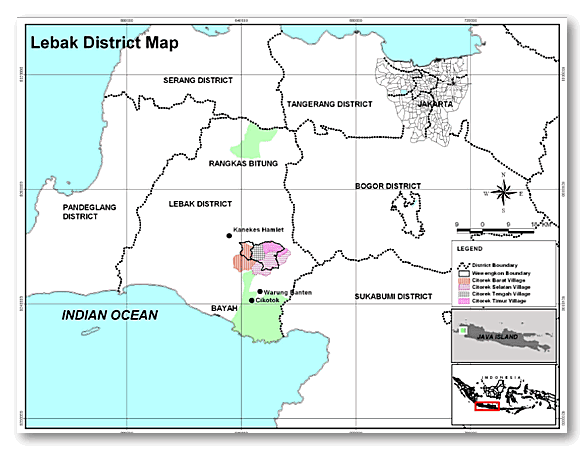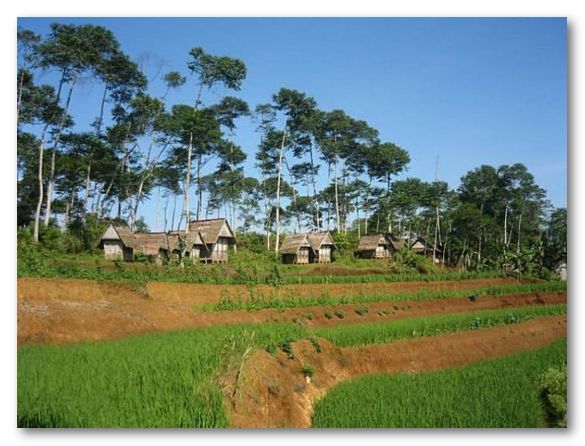Sandra Moniaga
Well-maintained irrigated ricefields located in one of the Ministry of Forestry’s claimed ‘state forest areas’Sandra Moniaga |
Citorek Kasepuhan is a adat (customary) community in Lebak district, Banten, some 200 kilometres from Jakarta. Community members consider the 7400 hectares of land they live on to be theirs, adat land by right. But the Ministry of Forestry regards a large part of that area as state forest, because it is located within the boundaries of Mount Halimun-Salak National Park. The area has been contested since the early 1900s, when the Dutch colonial government gazetted two-thirds of Kasepuhan’s adat land as state forest, and designated the other third as enclaves of private land for the community within the park.
Today, the Citorek Kasepuhan adat community still has little land tenure security. For their livelihood, most community members conduct farming, fishery and forestry activities on lands that are formally state forest areas. Some fear losing these lands; others face intimidation and legal judgments on charges of illegal logging. Some village residents would like to make substantial investments in land improvements, but refrain because they lack the necessary tenure security.
As well as forestry, fishery and farming, some Kasepuhan community members secretively engage in gold and lead mining, an activity which is not regulated in their own adat, but considered illegal under state law. The officers of the National Park have an ambiguous attitude toward the Citorek Kasepuhan community, sometimes trying to restrict their activities, at other times recognising their customary rights. This ambiguity makes it difficult for the park managers to draw up park management plans. The legal status and future of activities in this national park are full of uncertainty for all stakeholders.
The Lebak district government and legislature are familiar with the issue. The community has asked them to recognise their adat land rights. However, overlapping government authorities and gaps in political will make it hard to resolve the problem. Some laws and regulations empower the district government to solve these land conflicts, while others assign that authority to the Ministry of Forestry. Because the bulk of Citorek’s adat lands overlap with state forest, the district government asserts that the Ministry of Forestry holds the authority to resolve land conflicts. Meanwhile, the Ministry of Forestry says it has to wait for a provincial or district regulation on adat communities and their lands.
Forests and land rights
There are many ways to define what is a ‘forest’. If asked to do so, most of us immediately think of a place with a lot of trees. But many areas in Indonesia that government agencies classify as forests are actually village home sites, irrigated rice fields, fruit groves, upland rainfed farms, fishponds, or grazing lands.
Why do government agencies claim these agricultural lands as state forest areas? The formal legal answer is that according to the 1999 Forestry Law, ‘forest area’ means a certain area designated or stipulated by the government to be retained as permanent forest, and ‘state forest’ means a forest located on ‘lands bearing no ownership rights’ (the Indonesian phrase is ‘tanah yang tidak dibebani hak atas tanah’). The Ministry of Forestry uses these legal definitions to continue claiming 134 million hectares across Indonesia as ‘state forest’. The Center for International Forestry Research (CIFOR) estimates that in 2004 some 49 million people in Indonesia lived on lands classified as state forest.
Many areas in Indonesia that government agencies classify as forests are actually village home sites, irrigated rice fields, fruit groves, upland rainfed farms, fishponds, or grazing lands
Many adat communities in Indonesia have little tenure security for lands they have been living on, managing, or cultivating for generations. After the fall of the authoritarian Suharto regime in 1998, Indonesian reform advocates hoped the democratisation process would open up opportunities for formal recognition of adat communities’ customary land rights. Achievements by several adat communities in some districts, and by indigenous peoples in other countries, were a source of inspiration to the adat communities and their supporters. Yet, the government continues to consider many adat lands as state domain, state forest areas, or as no-man’s-land. Such centuries-old policies, dating to colonial times and even before in some cases, have resulted in adat communities losing control over their lands.
Why do adat communities still not enjoy legally secure rights over their lands? As part of Indonesia’s post-Suharto reforms, both human rights and adat rights were recognised in the constitution (the latter happened in 2002). This recognition should flow though to formal legal recognition of adat communities’ rights to their lands. Provisions in new legislation on human rights, regional autonomy and natural resources should have the same effect. In fact, little progress has been made. Why is this so, and what more must be done to provide secure land rights for Indonesia’s adat communities?
Colonial legacy and authoritarian continuity
 |
Map of Lebak district showing the location of Citorek KasepuhanImam Hanafi |
The state has ignored the land rights of adat communities since Dutch colonial times. The colonial government wanted land for commercial and conservation purposes, and appropriated land ‘that was not used by the local population’. The 1865 Forest Law gave the colonial state exclusive rights over forests, as did the Agrarian Law of 1870. Agrarian Decree No. 118 was the crucial implementing regulation of this law, and is still well known for its domein verklaring (declaration of state domain). The 1865 Forest Law was later replaced by the Forestry Decree of 1927 on Forestry in Java and Madura, which became the legal basis for delineating state forest and for gazetting state forest land in Java. This 1927 Forestry Decree legitimised turning adat community lands into state forest areas.
The Japanese colonial government during World War II did not restrict the use of state forest areas in Java by local populations. Communities used this moment of weakened control over forest areas to reclaim their lands, and they often did so with the support of local authorities. However, reclaimed lands were never legally registered. After Indonesia declared Independence in 1945, impoverished villagers continued to encroach into forest areas to grow crops and cut wood. In 1949, at least 400,000 hectares, or 14 per cent of Java’s state forest areas, were occupied by peasants, or deforested by civilian and military wood thieves.
The Center for International Forestry Research (CIFOR) estimates that in 2004 some 49 million people in Indonesia lived on lands classified as state forest
The Basic Agrarian Law No. 5/1960 recognised the existence of adat law communities and communal adat land rights. However, in practice this did not have any effect on the status of adat lands or on people’s activities in the forest, as there were no implementing regulations for the Basic Agrarian Law that acknowledged adat lands. Implementing regulations that recognise adat lands were not issued until 1999, almost 40 years later.
Under the Suharto regime, Indonesia’s forestry administration became more powerful and centralised. The forest was a major source of revenue for the state, and for private businesses which cultivated close relationship with the powerholders. Law No. 5/1967 on Forestry and its implementing regulations set up a system of forest use designation and timber concessions that remained in place for over 30 years, reinforcing government claims to state forest areas. The Suharto regime then established the Ministry of Forestry and gave it administrative control over all state forest lands within a context of authoritarian rule and state-led economic growth. The Basic Agrarian Law, with its promises of redistribution and community control could only be applied outside of state forest areas. The 1967 Forestry Law, administered by the Ministry of Forestry, covered all the state forest areas the government claimed, some 61 per cent of Indonesia’s total land area.
Contrary to the spirit of reformasi, the new law explicitly validated the status of forest areas that had been designated before the 1999 law was enacted, thus confirming the Ministry of Forestry’s control over huge tracts of Indonesia
Community land rights supporters hoped for change after Suharto, especially during the early days of reformasi in the late 1990s. The 1945 Constitution was amended between 1999 and 2002. It recognised the existence of adat law communities and their rights (with conditions). A new Forestry Law (No. 41/1999) delegated the authority to identify adat communities and their rights to provincial governments and district legislatures. It turned recognition of customary communities and their land rights from a human right into a political decision. Contrary to the spirit of reformasi, the new law explicitly validated the status of forest areas that had been designated before the 1999 law was enacted, thus confirming the Ministry of Forestry’s control over huge tracts of Indonesia, including areas where customary communities and millions of farmers live.
Lesson learned
Since 1998, the Citorek Kasepuhan community and other adat communities in Lebak have had greater opportunity for advocacy and to put forward legal arguments for recognition of their land rights. But they have had little success. They have learned that laws that recognise customary land rights are inconsistent, unclear and incomplete, even after the constitutional amendments of 2002. These legal realities, together with political and economic changes within the district and lack of political will on the part of the central government, constitute major challenges for them. Other adat communities throughout Indonesia who seek formal legal recognition of their land rights face similar challenges.
But weak internal capacity and organisation also limit many groups’ ability to engage in political legal and advocacy. Some adat communities are not very good at promoting their cause to the wider public. This is certainly the case with the Kasepuhan adat community, including the Citorek. Local politicians and community leaders in Banten often comment that the Kasepuhan lack the public profile of other adat communities, like the Baduy. Because there is little sympathy for the Kasepuhan in the wider public, local politicians feel no sense of urgency in responding to their needs.
Adat communities and other forest peoples are some of Indonesia’s poorest and most marginalised people. They need support to enhance their livelihoods and one way to give them that support is through restitution of their land rights. At the same time, state institutions need a clear mandate to implement democratic governance in a way that benefits local communities, including those living is so-called ‘state forests’. And everyone knows that Indonesia’s natural resources are degrading quickly, and need to be managed properly by all parties.
These efforts require a critical review of all relevant laws and regulations, with revision or replacement where necessary. Government agencies, at the central, provincial and regional levels, need to talk to adat communities about how to find a common vision for such a thorough-going legal review.
However, reform of state law is not the only solution. Adat needs to be transformed as well, and adat communities should receive legal education and services in accordance with their wishes. Adat institutions and community economic resources need to be strengthened.
The challenges of preventing environmental degradation and promoting community empowerment in Indonesia’s so-called state forests are enormous. They require nothing less than the development of a new legal paradigm within the state apparatus and society at large. ii
Sandra Moniaga (sandram@cbn.net.id) is a scholar and activist who focuses on environmental justice and community rights advocacy. She works with various organizations in Indonesia. She joined the Van Vollenhoven Institute in the Faculty of Law, University of Leiden in 2003-2008, and is currently completing her Ph.D. with the same institution. It includes the Lebak research reported in this article.
